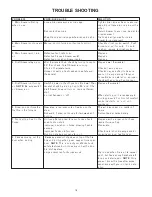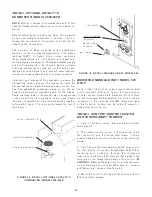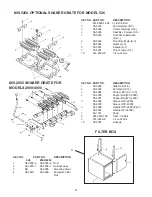
19
When using approved factory built metal chimneys, you
must have at least 2" of clearance when going through
a wall or next to a wall. A typical factory chimney instal-
lation is shown on figure 9.
INSTALLING YOUR WOODCHUCK
Most of the Woodchuck furnace is factory assembled.
The factory assembly should be located as detailed in
the PLACEMENT AND MINIMUM CLEARANCES sec-
tion and on figure 7.
Remaining assembly will consist of mounting the con-
trols, draft and circulating blowers, filter box if used, and
electrical connection. These details will be provided af-
ter stove pipe and air duct installation.
STOVE PIPE INSTALLATION
Install your Wood/Coal unit as close to the chimney as
possible with a minimum of elbows. We recommend no
more than two elbows. The maximum horizontal run
should not exceed 6 feet with a 1/2" rise per foot. The
pipe should maintain a minimum of a 1/2" rise per foot
and NEVER be installed closer than 18" from combusti-
bles. Exceeding these recommendations normally rep-
resents creosote build-up, a smoking furnace, or one
with poor draft.
When connecting stove pipe, all joints should be se-
cured with at least three #10 sheet metal screws.
NOTE:
If it is absolutely necessary to make a run
greater than 6 feet (not recommended), use extra sup-
port brackets every 3 ft.
The connection to the wood furnace’s collar must also
be more than just a snug fit. Drill holes through the
Woodchuck’s collar and secure with sheet metal
screws. Mark each connection for cleaning. This will
prevent frustration when matching up your hole pattern
again.
DAMPERS IN STOVE PIPES
A manual damper may be installed at a safe convenient
place between the barometric damper and the chimney.
In the event of chimney fire, it can quickly be closed
reducing draft to the chimney. See figure 10.
INSTALLATION OF A BAROMETRIC
DRAFT
Some codes and NFPA require draft regulators in the
chimney connector of wood or coal furnaces and boil-
ers, and manufacturers recommend their use with some
stoves. There is some doubt among wood heat experts
as to whether use of barometric draft regulators is wise.
Draft regulators limit the draft-the suction pulling air into
the appliance. A pivoted, counter-balanced flap is
pulled open by the draft when the draft reaches a criti-
cal amount (figure 10). This permits air to enter the
chimney, thus preventing the draft in the appliance from
rising any higher.
Use of draft regulators with oil-fired equipment is com-
mon. One objective is to keep the oil flame from being
blown out by excessive draft. This is more an annoy-
ance than a safety problem since most oil burners have
primary safety controls which stop the fuel flow into the
burner whenever the flame goes out, and modern
flame-retention burner design makes draft regulation al-
most unnecessary for this objective.
A second objective is to limit the amount of air passing
through the system in order to maintain high heat trans-
fer efficiency. Another desirable consequence is a de-
crease in peak chimney temperatures due to the added
air entering through the regulator.
High draft does not blow out the flames but fans them in
wood and coal burning equipment. An especially hot
fire can result. Control of the fire may be difficult, partic-
ularly if the wood burner is not airtight. Energy efficien-
cies may be adversely affected, and chimney fires may
be ignited. A barometric draft regulator can alleviate
these problems by limiting the flow of combustion air
into the appliance and by adding cooling air to the hot
flue gases.
However the cooling air may result in more creosote
accumulation, and if a chimney fire does start, it will be
more intense because of the draft regulator. Large
flows of air into the regulator will fan the fire in the
chimney. Thus the net effect of barometric draft
regulators is unclear-they help in some aspects, and
hurt in others. Note, though, that if a chimney is clean
so that chimney fires are impossible, a draft regulator
does no harm, and does help limit the intensity of the
fire in the appliance, and it helps prevent the flue gases
in the chimney from getting too hot. Barometric draft
regulators are recommended by JFPA for hand fired
thermostatically controlled solid fuel furnaces.
SUGGESTED TYPE
DAMPER
AIR HOLES
















































